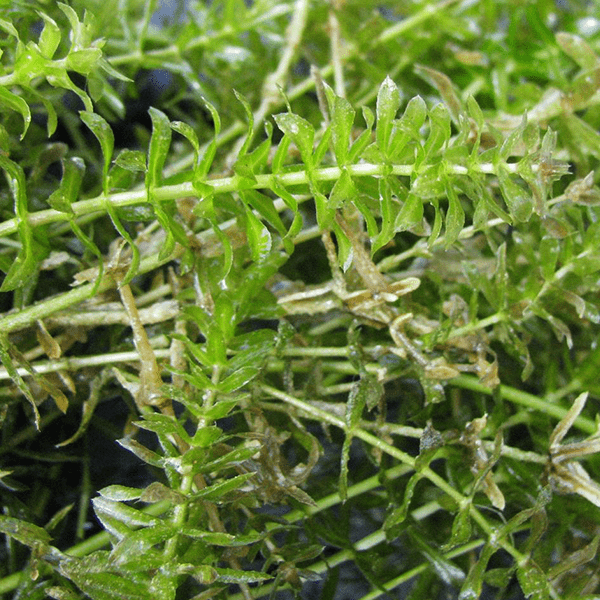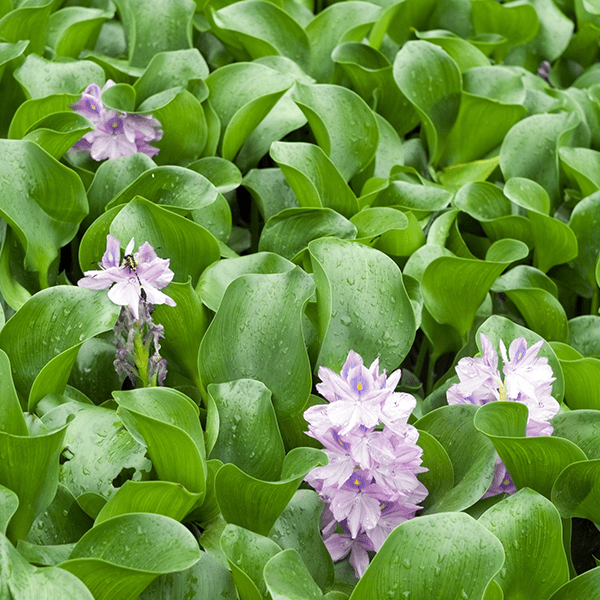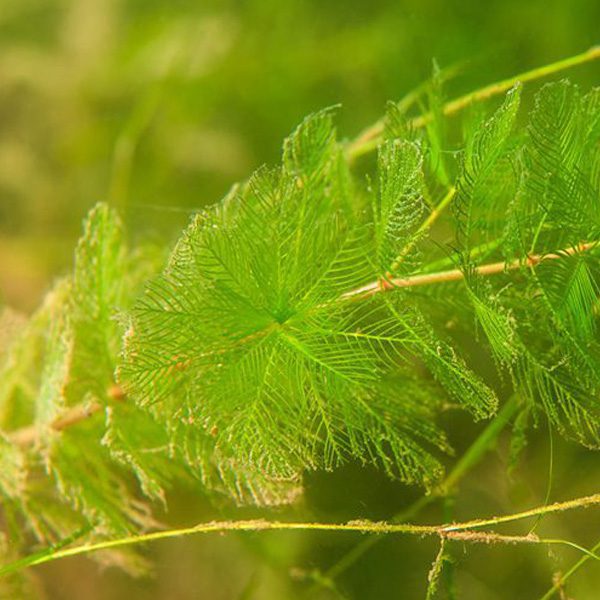Managing Nuisance Aquatic Plants
LCRA is offering rebates for the cost of managing nuisance invasive aquatic plants to municipalities, counties and property/homeowners associations on lakes Inks, LBJ and Marble Falls. Read more.

HYDRILLA

WATER HYACINTH

EURASIAN WATERMILFOIL
Invasive aquatic plants such as hydrilla, water hyacinth and Eurasian watermilfoil are sometimes found in the Highland Lakes.
LCRA manages hydrilla and water hyacinth on the Highland Lakes when the plants have the potential to impact LCRA dam or power plant operations. LCRA does not manage Eurasian watermilfoil and other vegetation that poses no threat to LCRA infrastructure operations.
Lakeside property owners with approved treatment plans can use physical (mechanical or manual) or chemical (herbicide) methods to remove nuisance aquatic plants under certain conditions, as described below.
LCRA recommends not treating or removing native plants such as cabomba, coontail, American pondweed, water stargrass, spatterdock and eelgrass as they provide important habitat for fish and other aquatic organisms.
Managing nuisance aquatic vegetation on the Highland Lakes
Lakeside property owners can manage nuisance aquatic vegetation on the Highland Lakes following processes described in this section. (Note that as of April 1, 2024, property owners on lakes Inks, LBJ and Marble Falls should follow a treatment zone schedule.) All treatment proposals must be approved in advance by the Texas Parks and Wildlife Department (TPWD) and LCRA. No one should attempt to manage aquatic vegetation in a public waterway without the required approval.
Treatment proposal forms must be submitted to TPWD at [email protected] and to LCRA at [email protected]. LCRA strongly recommends contacting a licensed herbicide applicator to design and implement a treatment plan.
A list of licensed herbicide applicators and aquatic plant management companies is available on the AquaPlant Diagnostics tool.
The list of LCRA-approved herbicide active ingredients is available here.
LCRA recommends that invasive aquatic plants be physically removed rather than treated with herbicides. Plants that are treated with herbicides can decompose and turn into a nutrient source for other plants and algae to grow in the same area.
Lakes Inks, LBJ and Marble Falls treatment zone schedule
Property owners on lakes Inks, LBJ and Marble Falls who have approved treatment proposal plans may treat nuisance aquatic vegetation with herbicides only during specific time periods listed in the treatment zone schedule provided in the map below.
The treatment zone schedule is designed to coordinate efforts, make treatments more effective and provide better situational awareness for people using water from the lakes. The plan divides property along Inks Lake, Lake LBJ and Lake Marble Falls into separate zones, with each zone having its own herbicide treatment schedule. The treatment zone plan is consistent with the State Aquatic Vegetation Plan.
The zone plan allows lakeside residents to treat for nuisance aquatic vegetation using herbicides four times a year and streamlines the notification process for property owners and public drinking water facilities. The plan also identifies a list of herbicide active ingredients approved for use in the Highland Lakes.
To determine a property’s zone, enter the address on the map below, then click on the colored line or symbol for treatment schedule information, including the treatment proposal application deadline, approved treatment time ranges and period when herbicides may be present in the water. Properties in the red circles are within 600 feet of public drinking water intakes. Properties in the gray circles are near the junction of two treatment zones.
Property owners on lakes Inks, LBJ and Marble Falls should only treat aquatic vegetation during their zone’s treatment schedule dates.
Manual or mechanical removal of aquatic vegetation
Property owners may remove aquatic vegetation using manual or mechanical methods at any time, without regard to the treatment zone schedules, provided the proposal has been approved by TPWD and LCRA.
On the TPWD Nuisance Aquatic Vegetation webpage, TPWD says: “Physical removal of exotic (non-native) aquatic plants designated as harmful or potentially harmful species requires an Aquatic Vegetation Removal Permit for Exotic Species except for removal by lakefront landowners/managers or their agents with an approved Treatment Proposal, provided the plants can be securely black bagged or fully dried or composted before transport for disposal. Anyone who is not a lakefront landowner/manager or their agent, who is removing these plants for hire or using a mechanical harvester, or landowners who cannot bag or fully dry the plants prior to transport for disposal must always obtain a permit. There is no cost for this permit for public waters.”
How to submit aquatic vegetation treatment proposals
Any property owner planning to manually or chemically control any aquatic vegetation from lakes Buchanan, Inks, LBJ, Marble Falls and Travis must submit the following to the TPWD Inland Fisheries Management District Supervisor Patrick Ireland at [email protected] and LCRA at [email protected]:
- A completed treatment proposal form.
- Property owners on lakes Inks, LBJ and Marble Falls using herbicides should follow the treatment zone schedule included on the above map.
- Treatment proposals for other waterways or for manual/mechanical removal of vegetation may be submitted at any time.
- A map delineating the proposed treatment area.
- Photographs of the plant and the problem it is causing.
TPWD and LCRA must approve or deny treatment plans within 14 days of receiving the proposals. If the proposed plan is approved, the property owner or applicator must then issue a notice of intent. TPWD requires that a notice of intent to apply herbicides be sent to water providers with intakes within 2 river miles of the treatment area at least 14 days prior to using herbicides in the lakes. This map from the Texas Commission on Environmental Quality (TCEQ) provides contacts for those public water intakes. In addition, property owners must also notify everyone on the state’s Herbicide Use Notification list at least 14 days prior to treatment when herbicides are used. Notice must also be provided to LCRA at [email protected] and to the TPWD at [email protected].
The notice of intent must include:
- All label information for the aquatic herbicide to be applied (this requirement may be fulfilled by providing the URL of an internet site with the specimen label);
- A statement that the TPWD guidance document has been reviewed and the proposed herbicide application is consistent with the principles of integrated pest management, §57.932(a)(2) of TPWD rules, and the guidance document; and
- Information demonstrating the proposed application will not result in exceeding the maximum contaminant level (MCL) of the herbicide in finished drinking water as set by the TCEQ and the Environmental Protection Agency (EPA), or the maximum label rate if the herbicide does not have an MCL established by the TCEQ and the EPA; and the Texas Department of Agriculture applicator license number, if any.
An example “Proposed Herbicide Use Notice” is provided on page 49 of TPWD’s Aquatic Vegetation Management in Texas: A Guidance Document.
More information on the treatment proposal process is available on the TPWD Nuisance Aquatic Vegetation website.
FAQs
What can I do to manage aquatic vegetation around the shoreline of my property?
The Texas A&M Agrilife Extension AquaPlant diagnostics tool provides guidance for plant identification and plant specific management. The tool also provides a list of professional applicators.
The Texas A&M AgriLife Extension provides management options for controlling Eurasian watermilfoil and hydrilla, two of the more common nuisance invasive aquatic plants. Please note the mention of using fertilizer or dyes as a management option in the links DOES NOT apply to public waterways. That is a management option specific to small ponds only. Please see the herbicide control options section of the linked information for examples of products that contain the LCRA-approved active ingredients listed in the below FAQ.
Which herbicide active ingredients can be used in the Highland Lakes?
LCRA has approved the use of herbicides with the following active ingredients in the Highland Lakes: Bispyribac, Copper, Diquat, Endothall, Flumioxazin, Fluridone, Imazamox, and Florpyrauxifen-benzyl: 2-pyridinecarbolic acid, 4-amino-3-chloro-6-(4-chloro-2-fluoro-3-methoxy-phenyl)-5-fluoro-, and phenyl methyl ester. None of the approved active ingredients have recreational use restrictions, but some have restricted uses for irrigation, livestock consumption or potable purposes. To be notified of any proposed herbicide treatments in public waters, sign up on the TPWD Herbicide Use Notification List.
See the product label and Section III.C.3. of the TPWD aquatic vegetation management guidance document for more information. Using an herbicide in a manner inconsistent with product label instructions is a violation of the law.
Is LCRA offering rebates for managing aquatic vegetation?
LCRA is offering rebates to cities, counties and property/homeowners associations to assist in offsetting the cost of managing invasive aquatic vegetation on lakes Inks, LBJ and Marble Falls in the spring and summer of 2024.
Should I avoid recreating in the lakes because herbicides may be present?
None of the approved herbicide active ingredients have recreational use restrictions when applied according to label instructions. Using an herbicide in a manner inconsistent with product label instructions is a violation of the law.
Anyone recreating in the Highland Lakes should always use caution and good judgment before entering the lakes. For more safety tips, visit Be LakeWise.
What about treating aquatic vegetation on lakes Buchanan and Travis?
Aquatic vegetation treatment proposals pertaining to these two lakes may be submitted at any time. The treatment zones do not apply to lakes Buchanan or Travis because the reservoirs fluctuate significantly and do not typically experience significant long-term vegetation issues.
What about treating aquatic vegetation on Lake Austin or Lady Bird Lake?
If I have property on lakes Inks, LBJ or Marble Falls, why do I need to know about the treatment zone schedule if I’m not treating aquatic vegetation?
Knowing that herbicides may be in the water at specific times may be helpful to nearby property owners as they decide whether to use lake water for irrigation or other uses. Some of the herbicides approved for use in the zone treatment plan do have irrigation restrictions. Property owners can determine when herbicides could be present in the water near their property based on the zone schedule by entering their address into the treatment zone map above and viewing the information in the table for the zone.
How can I help stop the growth of invasive plants?
- Clean, drain and dry your boats when entering or leaving a lake to avoid transporting non-native species. Leaving a public water body without removing plants and draining all water from your boat and trailer is illegal.
- Reduce or eliminate fertilization on lakeside properties.
- Plant native vegetation buffer strips along the lakeshore to filter the nutrients from rainfall or irrigation runoff coming from lawns.
- Don’t let grass clippings and leaves get into the lake.
- Clean up pet waste.
- Make sure septic systems are properly maintained to prevent excess nutrients from leaching into waterways that plants can use to grow.
What can I do to protect water quality of the lakes?
For questions about nuisance aquatic vegetation, contact TPWD at [email protected] or LCRA Water Quality at [email protected].


Social Media